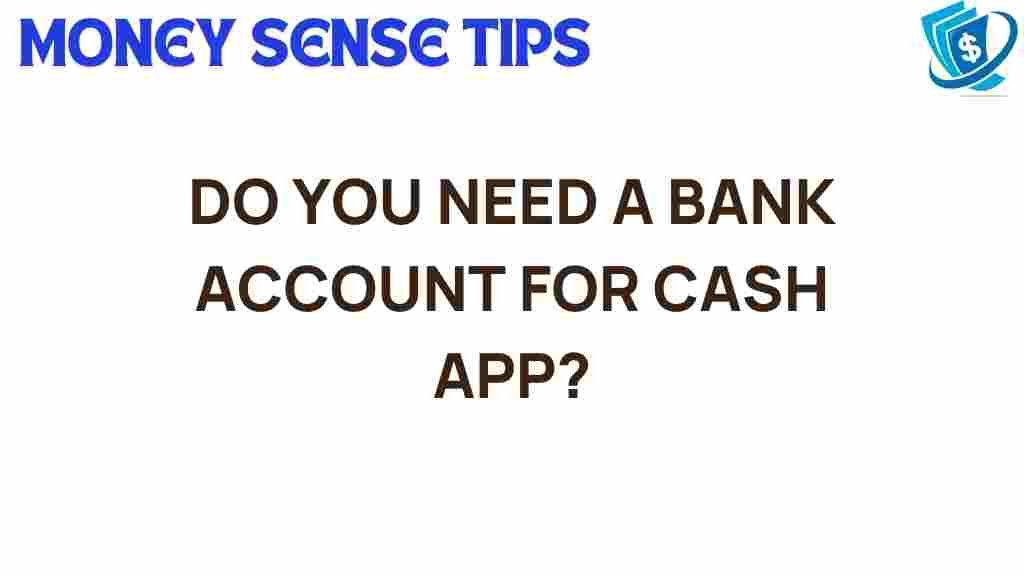Unlocking Cash App: Is a Bank Account Truly Necessary?
In today’s fast-paced digital economy, mobile payments and digital wallets have transformed the landscape of personal finance. One of the most popular platforms for managing money is Cash App. This innovative financial service allows users to send and receive money effortlessly. However, a common question arises: is a bank account truly necessary to use Cash App? In this article, we will explore the functionality of Cash App, its relationship with bank accounts, and various banking alternatives, helping you to make informed decisions about your financial management.
Understanding Cash App
Cash App is a mobile payment service developed by Square, Inc. It enables users to transfer money to one another using a mobile app. Cash App also offers features such as direct deposits, cash cards, and Bitcoin trading, making it a versatile tool for personal finance.
Some of the key features of Cash App include:
- Money Transfer: Send and receive money instantly from friends and family.
- Direct Deposit: Get your paycheck deposited directly into your Cash App account.
- Cash Card: A debit card linked to your Cash App balance that can be used for purchases.
- Investing: Buy and sell stocks or cryptocurrencies directly within the app.
The Role of a Bank Account in Cash App
While Cash App is designed to function independently, many users wonder if a bank account is necessary. The answer is nuanced. Here’s a breakdown:
Using Cash App Without a Bank Account
Yes, you can use Cash App without linking a traditional bank account. Here’s how:
- Create Your Account: Sign up for Cash App using your phone number or email address.
- Add Funds: You can add funds to your Cash App account through various methods, like receiving money from others or using a debit card.
- Send and Receive Money: Use your Cash App balance to send money to others or receive payments without needing a bank account.
Benefits of Linking a Bank Account
Linking a bank account to your Cash App account offers several advantages:
- Instant Transfers: When you need to transfer funds from Cash App to your bank account, linking it allows for quicker transfers.
- Direct Deposits: You can receive your paycheck directly in Cash App, enabling you to manage funds seamlessly.
- Increased Limits: Linking a bank account often increases the amount of money you can send, receive, and withdraw.
Step-by-Step Process: Setting Up Cash App
To start using Cash App, follow these steps:
1. Download the App
Available for both iOS and Android, download Cash App from the App Store or Google Play Store.
2. Create an Account
Open the app and enter your phone number or email to create an account. Follow the prompts to verify your identity and set up your profile.
3. Add Payment Methods
You can add a debit card, credit card, or link a bank account. If you prefer not to use a bank account, you can still add funds through debit or credit cards.
4. Start Using Cash App
Once your account is set up, you can start sending and receiving money. Enter the amount, select the recipient, and hit send!
Cash App vs. Traditional Banking: Pros and Cons
When considering whether to use Cash App alone or alongside a bank account, it’s important to weigh the pros and cons:
- Cash App Pros:
- User-friendly interface and easy setup.
- Instant money transfers.
- No monthly fees or minimum balance requirements.
- Cash App Cons:
- Limited customer service options compared to traditional banks.
- Withdrawal limits if not linked with a bank account.
- Potential fees for instant transfers or cash withdrawals.
- Traditional Banking Pros:
- Robust customer service and support.
- Access to a wider range of financial services.
- Higher withdrawal limits and account protection.
- Traditional Banking Cons:
- Monthly fees and minimum balance requirements.
- Slower transaction speeds.
- Less flexibility with mobile payments.
Troubleshooting Common Cash App Issues
If you encounter issues while using Cash App, here are some common problems and solutions:
1. Payment Failed
If a payment fails, check your internet connection and ensure you have sufficient funds. If the issue persists, restart the app or contact support.
2. Unable to Link Bank Account
Ensure you are entering the correct bank details. If the problem continues, try using another device or contact Cash App support.
3. Account Locked
Sometimes, Cash App will lock accounts for security reasons. Follow the prompts in the app to verify your identity and unlock your account.
4. Missing Funds
If you notice missing funds, check your transaction history. If there’s a discrepancy, contact Cash App support for assistance.
Conclusion: Making the Right Choice for Your Finances
In conclusion, Cash App is a revolutionary tool in the realm of financial services, offering various features that cater to users’ needs for mobile payments and money transfer. While it is possible to use Cash App without a bank account, linking one can provide additional benefits, such as higher limits and direct deposit capabilities.
Ultimately, whether you choose to use Cash App alone or in conjunction with a bank account depends on your personal finance needs and preferences. As banking alternatives continue to evolve, it’s essential to stay informed and explore the best options that align with your financial goals.
To learn more about mobile payments and how to manage your finances effectively, visit our resource page.
This article is in the category Services and created by MoneySenseTips Team

1 thought on “Unlocking Cash App: Is a Bank Account Truly Necessary?”